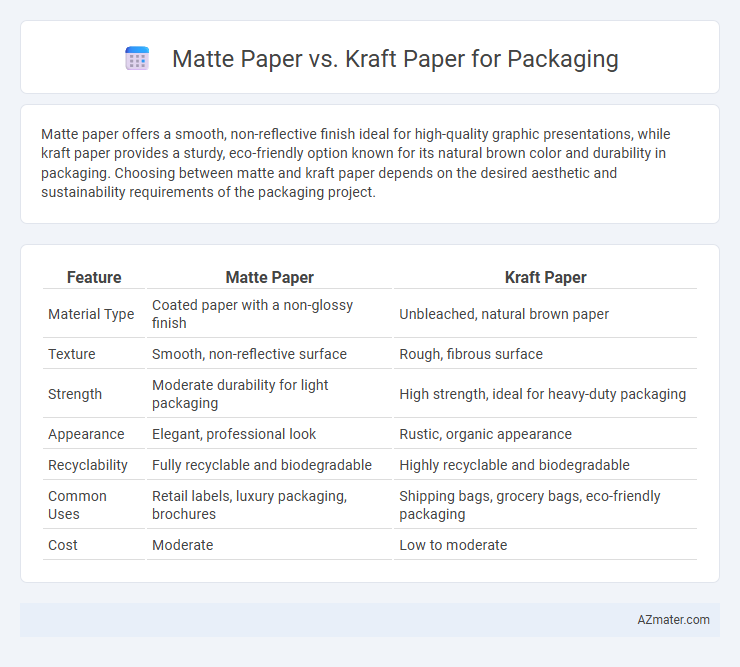Matte paper offers a smooth, non-reflective finish ideal for high-quality graphic presentations, while kraft paper provides a sturdy, eco-friendly option known for its natural brown color and durability in packaging. Choosing between matte and kraft paper depends on the desired aesthetic and sustainability requirements of the packaging project.
Table of Comparison
| Feature | Matte Paper | Kraft Paper |
|---|---|---|
| Material Type | Coated paper with a non-glossy finish | Unbleached, natural brown paper |
| Texture | Smooth, non-reflective surface | Rough, fibrous surface |
| Strength | Moderate durability for light packaging | High strength, ideal for heavy-duty packaging |
| Appearance | Elegant, professional look | Rustic, organic appearance |
| Recyclability | Fully recyclable and biodegradable | Highly recyclable and biodegradable |
| Common Uses | Retail labels, luxury packaging, brochures | Shipping bags, grocery bags, eco-friendly packaging |
| Cost | Moderate | Low to moderate |
Introduction to Matte Paper and Kraft Paper
Matte paper features a non-glossy, smooth surface that reduces glare and provides a sophisticated look, often used in high-end packaging to enhance visual appeal and tactile experience. Kraft paper, made from natural wood pulp, is known for its durability and eco-friendly properties, making it ideal for sustainable packaging solutions. Both materials cater to different branding needs, with matte paper emphasizing elegance and kraft paper highlighting rustic, environmentally conscious design.
Key Differences Between Matte and Kraft Paper
Matte paper offers a smooth, non-reflective finish ideal for high-quality printing and vibrant color reproduction, while kraft paper is manufactured from natural wood fibers, providing a rustic, durable, and eco-friendly option with a textured surface. Matte paper typically suits premium packaging requiring visual appeal and fine detail, whereas kraft paper is favored for its strength, recyclability, and natural brown appearance used in sustainable packaging. The choice depends on the desired aesthetic, printing requirements, and environmental considerations linked to packaging needs.
Visual Appeal: Matte vs Kraft Paper
Matte paper offers a smooth, non-reflective surface that enhances color richness and provides a sleek, modern look ideal for high-end packaging. Kraft paper, characterized by its natural brown tone and textured, rustic appearance, conveys an eco-friendly and artisanal brand image. Visual appeal depends on the desired brand aesthetic, with matte paper emphasizing sophistication and kraft paper highlighting sustainability and earthiness.
Texture and Touch: User Experience
Matte paper offers a smooth, non-reflective surface that enhances the tactile experience with a soft, velvety touch, making it ideal for premium packaging that emphasizes elegance and subtlety. Kraft paper features a coarse, fibrous texture that conveys a natural and rustic feel, appealing to eco-conscious consumers seeking authenticity and durability. Both materials influence user perception through their distinct tactile qualities, with matte paper favoring refined luxury and kraft paper providing rugged, organic appeal.
Durability and Strength in Packaging
Matte paper offers a smooth finish with moderate durability, making it suitable for lightweight packaging that requires aesthetic appeal. Kraft paper, known for its high tensile strength and tear resistance, excels in heavy-duty packaging applications and protects contents during transit. Brands prioritize Kraft paper for strength and eco-friendliness, while matte paper is chosen for premium presentation and moderate protection.
Sustainability and Eco-Friendliness
Matte paper and Kraft paper offer distinct benefits in sustainable packaging, with Kraft paper being highly eco-friendly due to its unbleached, natural fibers and biodegradability. Matte paper, often coated for a smooth finish, may include synthetic elements that reduce recyclability but can be sourced from recycled materials to improve sustainability. Choosing Kraft paper supports carbon footprint reduction and compostability, while matte paper's eco-friendliness depends on coating types and fiber sources.
Printability and Customization Options
Matte paper offers superior printability with vibrant color reproduction and excellent detail clarity, making it ideal for high-quality packaging designs that require intricate graphics and fine text. Kraft paper provides a rustic, eco-friendly aesthetic but has limited printability due to its coarse texture and natural brown color, which can affect ink absorption and color accuracy. Customization options on matte paper include a wide range of finishes and coatings, while kraft paper customization often focuses on natural dyes and embossing to enhance its organic appeal.
Cost Comparison: Matte Paper vs Kraft Paper
Kraft paper typically offers a more cost-effective solution for packaging due to its natural, unprocessed fibers and widespread availability, resulting in lower production costs compared to matte paper. Matte paper, with its smooth, coated finish designed for high-quality printing and aesthetic appeal, generally incurs higher manufacturing expenses that reflect in its price. Businesses choosing between matte paper and kraft paper should consider these cost differences alongside branding needs to find the most economical packaging option.
Best Uses and Industry Applications
Matte paper excels in premium packaging for luxury goods, cosmetics, and electronics due to its smooth, non-reflective surface that enhances print quality and brand perception. Kraft paper is favored in eco-friendly packaging for food, beverages, and industrial products, offering high durability, recyclability, and a natural, rustic appearance. Industries such as retail, foodservice, and manufacturing rely on matte paper for sophisticated branding and kraft paper for sustainable, robust packaging solutions.
Choosing the Right Paper for Your Packaging Needs
Matte paper offers a smooth, non-reflective surface that enhances print quality and brand aesthetics, making it ideal for luxury packaging requiring vibrant colors and detailed graphics. Kraft paper provides exceptional durability and eco-friendliness with its natural brown texture, suitable for sustainable, heavy-duty packaging needs. Selecting between matte and kraft paper depends on balancing visual appeal with strength requirements and environmental considerations for your packaging goals.

Infographic: Matte paper vs Kraft paper for Packaging
 azmater.com
azmater.com